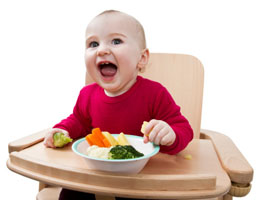
This situation is nothing out of the world, is it? Most people have given their parents a fair amount of trouble in their childhood, when it came to eating. Healthy meals for toddlers is a very dodgy issue. Here are a few tips that might help.
Healthy Meals for Preschoolers and Toddlers
Careful planning and analysis of your baby’s likes and dislikes is required to chalk out a nutritious meal plan. The following pointers would give you a fair idea as to what to consider while preparing meals for your baby.
Avoid Processed Stuff: Curb the use of processed and precooked food, in the food you prepare for your baby, as far as possible. Although there are claims that some food products are organic, that is not really the case. For babies, food should be cooked from scratch, using raw material to retain its optimum nutrition value.
Usage of Whole Foods: While preparing meals, it is always a good idea to use whole foods as ingredients, like fresh fish, cheese, plain/raw chicken breasts, or drumsticks. Amongst vegetarian ingredients, brown rice, whole wheat bread, unskinned potatoes, and fresh fruits top the healthy foods chart.
Keeping Tabs on Fats: To come up with healthy meals, inclusion of good fats is important. They are required for proper growth of the babies. Dairy products, untrimmed meat, and eggs are the most effective options to include proteins and good fats in a meal. Non-animal fats should also be a part of the food.
Old Wine, New Bottle: Take the same ingredients, and see if you can create different dishes using them. You would know which is the most favored dish for your little one.
If your kids are picky and finicky, you might consider altering your meal planning. Here are a few tips for the same.
Tips for Dealing with Picky Eaters
Dip, Spread, and Top the Foodstuff: Kids, according to experts, like to dip and smear things. So having a tasty dip made of cheese, peanut butter, and similar food products is just perfect. As far as spreading is concerned, have the kids spread the peanut butter, jam, or cheese on crackers, bread, toast, and the likes. Another way to ensure nutrition in a meal is to add healthy toppings on not-so-nutritious foods.
If not Solids Then?: If your kid is giving you a tough time while eating solid food, alter the strategy. Include semi-solids and liquids in your healthy meals for children. Smoothies, milk shakes, juices, eggs, honey, peanut butter, and yogurt would do the trick.
Variety is the Spice of Life: Apart from dipping and spreading, kids love to nibble on things. So, prepare a nibbler tray having small amounts of everything, from cereal to fruit, and dairy items to veggies. Keep it somewhere easily accessible, where the kid can notice it while going around the house.
Share the ‘Grub’: To put across a good example, if possible, have a neighborhood friend, who has no eating problems, come over at meal time. That child should like to eat so that your kid catches up with him/her. In this case, you could have a rough menu of a healthy meal for two, so that it becomes easier for you to prepare the food.
Let Them Have Their Own Way: If kids want to eat a particular thing at the time which is usually not the time for it, let it be. It is anytime better than not eating anything. For instance, if your kid asks for something like a sandwich or burger for breakfast, and cereal for lunch, it is fine. It would be a change for all the family members as well.
There are many more things like the presentation of the food, the seat while eating, and so on, which have an impact on your kid’s eating habits. However, these things are better left to those who are already in that zone. Eventually, the objective is to make the kid eat, no matter what tricks and tactics you use.

